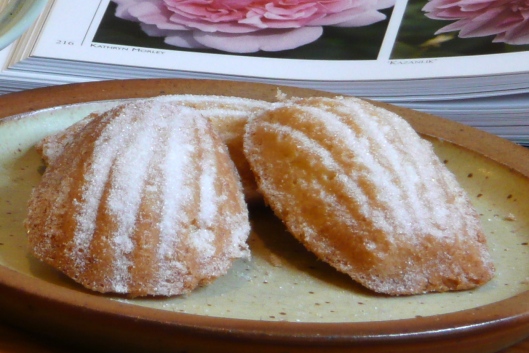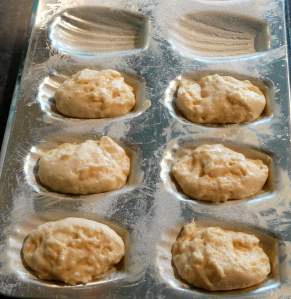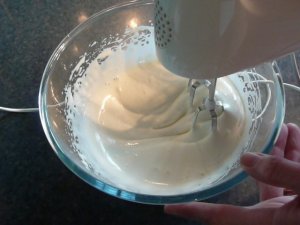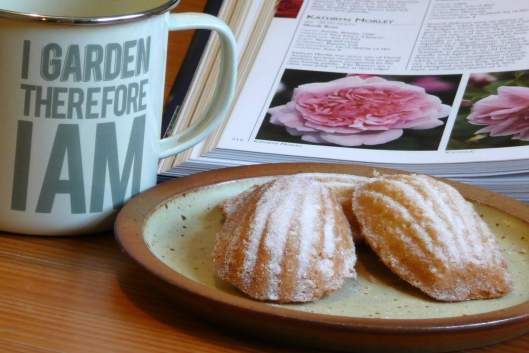 I have always loved Madeleines, and once, in a fit of excitement, I bought myself a tray to make them in. I’m embarrassed to admit that that may have been as much as fifteen years ago, and in all that time the tray sat unused in the cupboard, silently reproaching me every time I moved it out of the way to find a tin for a less challenging recipe (challenging in my eyes that is).
I have always loved Madeleines, and once, in a fit of excitement, I bought myself a tray to make them in. I’m embarrassed to admit that that may have been as much as fifteen years ago, and in all that time the tray sat unused in the cupboard, silently reproaching me every time I moved it out of the way to find a tin for a less challenging recipe (challenging in my eyes that is).
But then about six months ago, with a good deal more baking experience under my belt, I finally got around to making some madeleines. In fact they weren’t that hard, just requiring a bit of patience and delicacy at certain stages of the preparation. They turned out well, but my write-up about them got stuck in an ever increasing backlog of unwritten posts.
 Then I got a wake up call in the form of the Tea Time Treats challenge for May, which was for Floral Flavours and Flowers. Lots of ideas went through my mind, but in the end I decided to adapt a recipe for mini Rosebud Madeleines (in How to be a Domestic Goddess by Nigella Lawson).
Then I got a wake up call in the form of the Tea Time Treats challenge for May, which was for Floral Flavours and Flowers. Lots of ideas went through my mind, but in the end I decided to adapt a recipe for mini Rosebud Madeleines (in How to be a Domestic Goddess by Nigella Lawson).
Unlike hers, my madeleines were full sized, and I made a few other changes to the recipe, most notably using brown butter, and adding a little baking powder to the mix. I also multiplied the ingredients by three, so as to fill my tray of full-sized madeleines twice over. But if you want to make a different number, the ingredients divide nicely into three, so you could easily cater for 8 or 16, or even 32 or more!
Ingredients
- 150g unsalted butter
- 135g plain flour (type 00 if possible)
- 1/4 teaspoon baking powder
- A generous pinch of salt
- 3 large eggs
- 120g caster sugar
- 3 tablespoons rosewater (I used Steenbergs)
- A 12 mould madeleine tray
Method
First brown the butter. Melt it in a small pan over a medium heat, and keep it moving by swirling the pan until it turns a rich golden brown colour, the milk solids separate out, and it starts to smell nutty. Take it off the heat and dip the base of the pan briefly into cold water to stop the butter browning any further.
Sift the flour, baking powder and salt into a small bowl.
In a large bowl, whisk the eggs with the caster sugar until they are roughly tripled in volume, and the mixture has a thick creamy consistency which will retain the imprint of the beaters for a second or two.
Whisk in the rosewater.
Sift one third of the flour over the top of the mixture and fold in gently, then do the same with the rest of the flour. Make sure there are no secret veins of flour lurking in the mixture.
Now pour the butter down the side of the bowl, and gently fold that it too.
Cover the bowl, and leave to chill in the fridge for at least an hour. After this, the mixture will have the texture of set mousse.
Preheat the oven to 190C / 375F / Gas Mark 5 (adjust for fan oven).
 Butter the madeleine tray generously with melted butter, dust with flour, and shake out the excess. This is essential to ensure the madeleines come out of the moulds smoothly when baked.
Butter the madeleine tray generously with melted butter, dust with flour, and shake out the excess. This is essential to ensure the madeleines come out of the moulds smoothly when baked.
The madeleines will need to be baked in two batches, but the batter doesn’t mind sitting around. Just make sure to refresh the butter and flour in the moulds before filling for the second time.
Drop a rounded tablespoonful of the mixture into each mould. Leave a gap around the edge of the mould for the mixture to expand (roughly a half to 1 cm), and don’t spread it out.
 Bake for about 12 minutes, until golden brown around the edges and the centres spring back to the touch.
Bake for about 12 minutes, until golden brown around the edges and the centres spring back to the touch.
When you take the tray out of the oven, give it a sharp tap on the worktop to loosen the cakes. They may still need to be teased out gently with a knife. Cool on a wire rack. Which way up you do this depends on which is your favourite side.
Once cold, dust with caster sugar (or icing/confectioners sugar if you prefer).
Notes
Three tablespoons of rosewater may sound like a lot, but it works, and the final flavour is quite mild. Just make sure you’re using rosewater and not rose essence (which would require much less).
If you prefer, you can simply melt the butter. You’ll just won’t get the nutty taste of the browned butter.
You’ll find my post about classic madeleines here.



I keep debating whether to buy a madeleine tray as it seems so indulgent to buy something with only one purpose… But looking at these beauties I reckon it’s 100% worth it, they look gorgeous!
It does sometimes seem reckless to buy specialised equipment doesn’t it? But think how much it would cost to buy a few batches of decent madeleines and it doesn’t seem so extravagant. Well, that’s my excuse…
I am the very lucky owner of three vintage French Madeleine moulds and I ADORE Madeleines…..these are JUST beautiful and I think the idea of rose water is a fabulous idea….another lovely entry into Tea Time Treats, thanks so much for taking part! Karen
Thanks Karen. I’m jealous of your vintage madeleine moulds. I’m a sucker for baking equipment, and I find my madeleine tray very pleasing even with no madeleines in it!
Those look wonderful! I’m a big fan of anything with rosewater in it and always look for new ways to use it. I’ve never heard of rose madeleines, sound perfect to me!
I haven’t used rosewater very often, and was worried about the quantity in this recipe, but they turned out just right. I think I’ll be using it more often in future.
Brown butter and rose water – I find madeleines a bit boring usually but these are very tempting.
Covers face in horror at the use of the words boring and madeleine in the same sentence! Seriously though, I know what you mean. But these were definitely worth eating.
Pingback: Gigi’s Strawberry Cobbler | The Yum Yum Gigi’s Strawberry Cobbler | A Southern Guy's Blog about Eating
Pingback: Tea Time Treats – Say it with Flowers for May – BIG FAT FLORAL BAKING ROUND UP! Part One « Lavender and Lovage